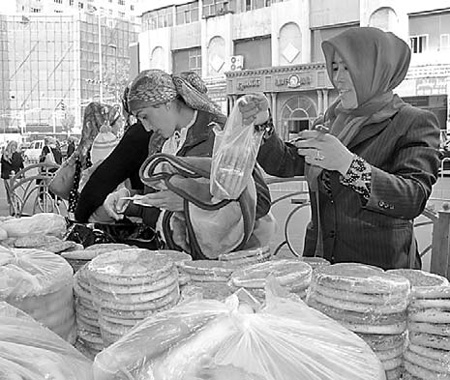Uygur breads on the barbecue
 |
|
Stacks of naan are popular with shoppers, who buy them to eat with milk tea and fruit. There are also other varieties of stuffed naan. Shao Wei / China Daily |
Xinjiang
Throughout the cities and towns of the Xinjiang Uygur autonomous region, it's common to see naan bakeries by the street side and a queue waiting patiently for freshly made flatbread.
Naan is part of the everyday diet here and is usually eaten together with milk tea or fruit.
"A good naan is made with water, egg and milk," says 24-year-old naan baker Aimait, as he busily rakes hot naan out of a clay oven with a long iron hook.
Aimait makes dough by blending flour, eggs, oil, milk and salt. He rolls out the dough and sprinkles sesame and onions on the surface, and finally throws it onto the floor of the hot oven.
After the dough puffs up and turns from white to a golden yellow, the bread is ready.
"Baking a naan takes only three to five minutes," the baker jokes. "It's our local fast food."
The naan is shaped like a plate, thicker on the rim than in the center, with a beautiful texture that combines a tender inside with a crisp crust.
Naan bread also keeps well, and it has been the preferred food for travelers since the days of the Silk Road.
This icon of Xinjiang cuisine also comes in many varieties. Some are stuffed with meat, some are crispy and soft like the "oil naan" and there is also the fresh and aromatic naan made from corn meal.
There is also steamed naan, known as wonang in the Uygur language, which is a steamed bun with a filling of minced mutton and onions with a paper-thin crust of flour. It's soft and glutinous and seems to melt in the mouth.
Naan has been eaten in Xinjiang for a long time, and records from about the 4th century also showed the presence of this flat bread.
In 1972, archaeologists found some well-preserved naan in the Astana Ancient Tombs in Turpan. The breads were found to be similar with the naan now made by the Uygurs in Xinjiang. The ancient naan dated back to 640 AD and were believed to be part of a sacrifice.
Finally, here's an etiquette tip from Aimat, our friendly baker.
"It's rude to bite into a naan in public. We break the naan up by hand, or cut them into smaller pieces to be shared with families and friends."


















